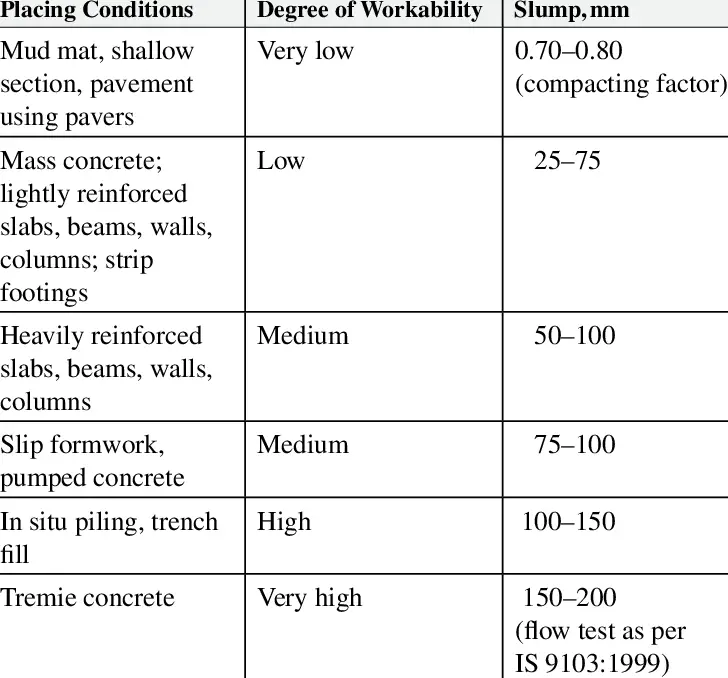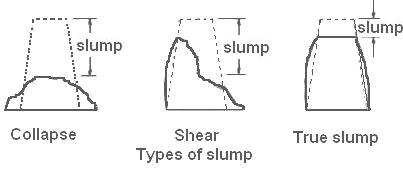Concrete Slump Testing Procedure & Equipment | Concrete Slump Chart Ranges
Concrete Slump Testing Procedure | Concrete Workability | Concrete Slump Numbers Chart
What Is Concrete Slump and How Is It Measured?
The concrete slump test is used to determine the consistency and fluidity of concrete. It demonstrates the flow of freshly mixed concrete and its overall workability.
Simply put, the greater the droop, the more liquid the mixture. Slump of four inches (4”) is quite frequent with average weight concrete and is ideal for pumping.
The test is popular due to the ease with which the apparatus is used and the procedure is followed. The slump test is used to check that different loads of concrete perform consistently under field conditions.
A specialized test, referred to as the flow table or slump-flow test, is used to determine the slump of concrete that is too fluid (unworkable) to be measured using the usual slump test, as the concrete would lose its shape when the cone is removed.
Concrete Slump Testing Procedure
Concrete Slump Testing Equipment’s /Kits
It is critical to gather the following tools/equipment’s before conducting the slump test:
- Slump Cone: Cone-shaped mold constructed of steel or plastic that measures 8″ (203mm) in diameter at the base, 4″ (102mm) in diameter at the top, and 12″ (305mm) in height.
- Base plate: The slump cone will rest on the base plate during the test, and the base plate should feature bolt-on clamps to secure the cone during testing. A grip on the base plate makes it easy to remove and also serves as a guide for measuring the slump.
- Tamping Rod: A steel rod used during testing that should have a diameter of.625″ (16mm) and a length of 24″ (610mm).
- Tape Measure: Used to determine the slump.
Step-by-Step Procedure of Concrete Slump Testing
The test is conducted using a metal mould in the shape of a conical frustum, also known as a slump cone or Abram’s cone, that is open on both ends and equipped with handles.
The tool is normally 100 millimeters (3.9 in) in diameter at the top and 200 millimetres (7.9 in) in diameter at the bottom, with a height of 305 millimetres (12.0 in).
The cone is set on a non-absorbent, hard surface. This cone is filled in THREE phases with new concrete. Each layer is tamped 25 times using a 2 ft (600 mm) long bullet-nosed metal rod with a diameter of 5/8 in (16 mm).
The concrete is struck flush with the top of the mould at the conclusion of the third stage. The mold is carefully raised vertically upwards without disturbing the concrete cone.
After that, the concrete slumps (subsides). The slump of concrete is determined by the distance between the top of the depressed concrete and the top of the slump cone.
How To Perform a Concrete Slump Test
Here is a Step-by-Step procedure of Concrete Slump Testing Procedure
- Place the mold on a flat, moist, non-absorbing surface like a steel plate.
- Fill them all to one-third full by volume and compacted it.
- Fill the mould to two thirds full and compact it.
- Each layer shall be tempted 25 times with a standard 16 millimeters diameter steel rod.
- Strike off the top surface of the concrete from the top of the mould to make it even
- Removed the mould carefully take about five seconds
- Immediately invert and place the mould beside the slumped concrete and place the rod horizontally across the mould and measure the slump.
Interpreting Slump Test Results or Types of Concrete Slumps
When performing the slump test, the following shapes of the concrete slump can be observed and documented in millimeters
Slumped concrete comes in a variety of shapes and is classified as true slump, shear slump, or collapse slump depending on its profile. If a shear or collapse slump occurs, a new sample should be taken and the test should be redone.
Only a true slump is relevant for the test. A collapsing slump indicates that the mix is either excessively moist or that it is a high workability mix, for which the slump test is inapplicable.
Concrete Slump Chart Ranges
Slump demonstrates the flow of freshly mixed concrete and its general workability. Simply put, the greater the droop, the more liquid the mixture. Slump of four inches (4”) is quite frequent with average weight concrete and is ideal for pumping.
Slumps that are larger than typical will diminish the concrete’s strength, durability, and permeability.
Here is Concrete Slump Chart Ranges
Concrete Slump Chart Table Guide
- Very dry mixes with a slump of 0–25 mm are typically used to construct pavements or roads
- Low workability mixes with a slump of 10–40 mm are typically used for foundations with light reinforcement
- Medium workability mixes with a slump of 50–90 mm are typically used for normal reinforced concrete placed with vibration
- High workability concrete with a slump of >100 mm is typically used where reinforcing bars are closely spaced and/or the concrete must flow a significant distance.
Types of Concrete Slumps
Collapse Slump
Collapse slump is when concrete collapses completely indicate the mix is too wet and is not appropriate. This is an indication that the water-cement ratio is too high, indicating that the concrete mix is excessively wet, or that the mix has a high workability, for which a slump test is inappropriate.
Zero Slump
Here the concrete maintains the shape of the mold. This type of concrete is too stiff and has almost no workability.
Shear Slump
When the top portion of concrete shears off and slipped sideways indicates harsh mixes like the mix’s lack of cohesion.
True Slump
True, when the concrete simply subsides. Here the general mass of the concrete drops evenly without any disintegration. This is the desired test result.
Slump Test Application
Slump Test is used to ensure uniformity for different patches of the similar concrete grade under field conditions
Helps to check on day to day or hour to hour variation in the materials being fed into the mixer
Recommended slump.
- About 50 millimeters when mixed manually,
- About 75 to 100 when required to pump the concrete.
What Does a Concrete Slump Test Tell You?
The slump test is used to determine the consistency of fresh concrete prior to setting. It is used to determine the workability of freshly mixed concrete and thus the ease with which the material flows. Additionally, it can be used to indicate a badly mixed batch.
Limitations of the Slump Test
The slump test is acceptable for slumps with a medium to low workability, with a slump of between 5 and 260 mm. However, the test is incapable of determining the difference in workability between stiff mixes with no slump and wet mixes with a collapsing slump. It is restricted to concrete composed of particles no larger than 38 mm in diameter (1.5 inch)
Another method is to use an automatic slump meter. The meters are equipped with sensors and controls that enable them to detect and display slump. Their dependability has won them recognition in a variety of standard codes, including those published by ASTM International.


